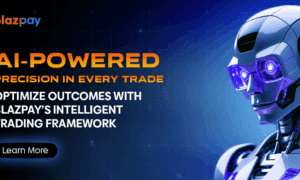Introduction
In today’s fast-changing financial world, platforms like Trade Vector AI are helping traders in Chile and across the globe use smart technology to make better investment choices. The growing connection between machine learning cryptocurrency tools and real-time market data is changing how people trade digital assets. What was once a risky and unpredictable market is now supported by artificial intelligence that learns, predicts, and adapts.
Machine learning (ML) is a type of artificial intelligence that helps systems analyze large amounts of information and recognize patterns. In the world of crypto, ML can study cryptocurrency prices live, detect trends, and even forecast short-term market moves. This allows traders to react faster and create more stable cryptocurrency trading strategies with data-driven insights rather than emotions.
Chile has seen a steady rise in crypto adoption. From individual investors to fintech startups, many are exploring how AI-based systems can improve returns and reduce risk. With trading platforms now offering access to cryptocurrency trading bots, it has become easier for both beginners and professionals to automate their decisions. These bots use ML algorithms that can learn from past trades and adjust to new market conditions in seconds.
This article explores how machine learning is transforming cryptocurrency trading strategies, what types of algorithms are being used, and what benefits they offer to investors. You will also discover how AI systems analyze massive data streams — from social media sentiment to live blockchain transactions — to deliver smarter, faster, and more accurate trading insights. By the end, you’ll understand how these technologies are redefining the way we see and trade cryptocurrencies in Chile and worldwide.
The Basics of Machine Learning in Cryptocurrency
To understand how artificial intelligence changes crypto trading, it’s important to first know what machine learning really means. In simple words, machine learning (ML) is a process where computers learn from data without being directly programmed by humans. Instead of following fixed rules, ML systems analyze information, find patterns, and make predictions on their own.
In the context of machine learning cryptocurrency systems, algorithms study huge sets of financial data. This includes cryptocurrency prices live, historical price movements, transaction volumes, and even market sentiment from news or social media. By processing this information, ML can identify small signals that often predict bigger market changes — signals that humans might miss.
There are three main types of ML used in crypto trading:
- Supervised learning – The model learns from labeled data, such as past prices and known outcomes. It’s ideal for predicting short-term price movements.
- Unsupervised learning – The system finds hidden patterns in unlabeled data, helping traders discover unknown relationships between coins and indicators.
- Reinforcement learning – This type teaches a cryptocurrency trading bot to make decisions by trial and error, rewarding good actions and punishing bad ones.
Let’s look at a simple example. Imagine an ML system analyzing data from the Chilean market. It tracks bitcoin’s past performance, checks how often prices rise after large buy orders, and studies trading activity during Latin American time zones. Based on this data, it can recommend an optimized cryptocurrency trading strategy that increases the chances of profit while reducing risk.
What makes ML powerful is its ability to adapt. As market conditions change — for example, during periods of volatility or after global news events — machine learning systems quickly adjust their models. This flexibility helps traders make better decisions and stay one step ahead in the competitive crypto environment.
Below is a simple table showing how ML differs from traditional trading approaches:
| Aspect | Traditional Trading | Machine Learning Cryptocurrency |
| Decision Basis | Human intuition and manual analysis | Automated data-driven predictions |
| Reaction Time | Minutes or hours | Milliseconds |
| Adaptability | Limited | Constantly learning and improving |
| Data Processed | Charts and reports | Massive datasets including cryptocurrency prices live |
How AI and Machine Learning Are Transforming Cryptocurrency Trading Strategies
In recent years, the combination of artificial intelligence and machine learning has completely changed how traders approach the crypto market. With tools like Trade Vector AI and other smart systems, investors can now use data-driven insights to develop a cryptocurrency trading strategy that reacts instantly to market changes. Instead of guessing where the market might go, AI helps traders base their actions on evidence, not emotion.
Machine learning models are built to analyze millions of data points from different sources — including cryptocurrency prices live, exchange order books, social media trends, and blockchain metrics. These models can recognize hidden signals that predict the next price move or identify potential opportunities before most people notice them. For example, an algorithm might detect when a coin’s volume is rising faster than usual, signaling a possible price breakout.
One of the most impressive results of AI in trading is the development of the cryptocurrency trading bot. These bots use ML algorithms to learn from past market behavior. Over time, they refine their strategies automatically, improving accuracy and profitability. Many bots can trade 24/7, reacting in milliseconds when new data appears — something no human can achieve.
Here are a few ways AI and machine learning are transforming crypto trading strategies:
- Predictive Analytics: AI tools forecast future prices by learning from historical data and identifying repeating patterns.
- Sentiment Analysis: ML systems scan social media and news sources to measure the mood of the market, which affects price direction.
- Risk Management: AI models calculate optimal stop-loss levels and portfolio allocations to minimize potential losses.
- Market Adaptation: Machine learning cryptocurrency systems automatically adjust to changing trends, reducing the effect of volatility.
Imagine a trader in Chile using an ML-powered bot that tracks cryptocurrency prices live. The bot notices a sharp movement in Bitcoin’s price due to a major announcement from a global exchange. Within seconds, it executes a buy or sell order, taking advantage of the opportunity before the majority of traders react. This type of automation makes trading more efficient, faster, and often more profitable.
In short, AI and machine learning give traders a new way to compete. They help users avoid emotional decisions, reduce mistakes, and base every move on hard data. For investors who want to stay ahead, using a smart cryptocurrency trading strategy supported by ML may soon become a necessity, not an option.
Types of Machine Learning Models in Crypto Trading
Machine learning is not a single technique — it is a wide group of models that help traders analyze data, recognize patterns, and make smart predictions. Each model has a unique way of processing information, which is why choosing the right one is essential when building a cryptocurrency trading strategy. Platforms such as Trade Vector AI use a mix of different models to provide more accurate insights for both new and experienced investors in Chile.
Here are the most common machine learning cryptocurrency models used in the market today:
- Linear and Logistic Regression: These models are simple but effective for identifying price trends. They analyze how variables like trading volume or volatility affect price movements and can estimate the probability of a price rise or fall.
- Decision Trees and Random Forests: These models make predictions by dividing data into smaller segments based on conditions. They are useful for identifying which factors most influence cryptocurrency prices live.
- Neural Networks (LSTM, CNN): Inspired by the human brain, these models are highly effective for time-series analysis. LSTM (Long Short-Term Memory) networks are great at learning long-term dependencies, while CNNs (Convolutional Neural Networks) excel in detecting complex visual or numerical patterns in charts.
- Reinforcement Learning: This model is commonly used to train a cryptocurrency trading bot. It works through trial and error — rewarding profitable decisions and punishing bad ones. Over time, the bot learns which actions produce the best results under different market conditions.
- Ensemble Methods: These models combine the strengths of several algorithms. By blending predictions, ensemble models can reduce errors and improve overall accuracy, making them ideal for uncertain crypto environments.
For example, a trading system might use a Random Forest model to identify potential buy signals, and then apply an LSTM network to predict short-term price changes. This hybrid approach allows traders to get both a broader and deeper understanding of market dynamics.
The advantage of using multiple ML models is clear: they complement each other. While one focuses on past patterns, another may capture real-time reactions from cryptocurrency prices live. The result is a smarter, faster, and more adaptable trading framework that helps traders in Chile make better decisions every day.
In essence, the type of machine learning model chosen defines the quality of your cryptocurrency trading strategy. As AI continues to evolve, these models are becoming more accurate, efficient, and capable of transforming the entire trading process into a science guided by data rather than guesswork.
Real-World Applications and AI Integration in Crypto Markets
The use of machine learning cryptocurrency systems is no longer just an experimental idea. Across the world — and increasingly in Chile — traders and fintech companies are adopting AI-powered tools to improve how they invest and manage risk. These technologies are now an essential part of modern trading platforms, helping users process massive amounts of information in real time.
Today, cryptocurrency trading bots run on advanced machine learning models that can read, interpret, and react to market data instantly. These bots are connected to multiple exchanges through APIs, giving them access to cryptocurrency prices live. They automatically identify price trends, predict sudden movements, and execute trades at optimal moments. The entire process happens within seconds, without emotional bias or hesitation.
Many AI integrations go beyond simple trading. Some systems use predictive analytics to forecast future market conditions or detect anomalies that may signal fraud. Others analyze blockchain data to identify wallet activity, track liquidity flow, or find potential investment opportunities before they become public knowledge. For Chilean traders, these insights are becoming a valuable way to compete in global markets.
Here are some key ways that machine learning and AI are being integrated into the crypto ecosystem:
- Algorithmic Portfolio Management: AI tools balance and diversify portfolios automatically based on performance data and volatility levels.
- Automated Market Making: ML systems help platforms provide liquidity while minimizing price manipulation risks.
- Real-Time Risk Analysis: Continuous monitoring of cryptocurrency prices live helps identify market shifts and protect capital during volatility.
- Trading Signal Generation: Advanced models generate buy/sell alerts using deep learning algorithms trained on years of price and sentiment data.
For instance, a trader in Santiago might use Trade Vector AI to connect multiple accounts and apply a personalized cryptocurrency trading strategy. The platform’s ML engine could analyze global market data, detect strong upward momentum in Ethereum, and trigger an automated purchase — all before manual traders even notice the movement. This kind of automation is what makes AI-driven systems so powerful.
In short, real-world applications of AI are proving that machine learning is not just a supporting tool — it’s becoming the core engine behind successful crypto trading. From reducing risk to maximizing profit, ML-driven automation is helping Chilean investors participate confidently in a market that never sleeps.
Benefits of Using Machine Learning in Crypto Trading
Machine learning is changing how investors in Chile and around the world approach digital trading. By combining data analysis and automation, machine learning cryptocurrency systems allow traders to make faster and more accurate decisions. Whether you are an individual investor or part of a larger trading firm, AI-based tools can offer important advantages that traditional methods cannot match.
Here are some of the main benefits of using AI and machine learning in crypto trading:
- Speed and Efficiency: A cryptocurrency trading bot powered by machine learning can analyze cryptocurrency prices live and execute trades within milliseconds. This allows traders to take advantage of market opportunities the moment they appear.
- Data-Driven Decisions: Instead of relying on emotions or predictions, AI systems use large data sets to form a smart cryptocurrency trading strategy. Every decision is based on facts and analysis, not guesswork.
- Risk Reduction: ML models help identify potential risks and calculate optimal stop-loss or take-profit points. This minimizes human error and emotional trading mistakes.
- Adaptability: The crypto market changes constantly. Machine learning systems can adjust in real time, learning from new data and improving performance automatically.
- 24/7 Operation: The cryptocurrency market never sleeps — and neither do AI bots. They can monitor cryptocurrency prices live day and night, ensuring that traders don’t miss any opportunity.
For example, a trader using Trade Vector AI might let an ML bot manage part of their portfolio. While the trader sleeps, the bot monitors volatility and executes trades that fit a predefined cryptocurrency trading strategy. In the morning, the trader wakes up to see detailed reports and new profits — all thanks to data and automation.
Ultimately, machine learning helps create a smarter, faster, and more secure trading environment. It gives traders confidence to act on insights, not instincts, and to grow their digital portfolios with precision.
Challenges and Limitations of Machine Learning in Crypto Trading
While machine learning cryptocurrency systems offer many benefits, they also face challenges that traders in Chile and worldwide must understand. Like any advanced technology, AI is not perfect — it depends heavily on the quality of data and the models behind it. Knowing these limitations helps investors make smarter decisions and use AI tools more effectively.
Here are some of the main challenges of using machine learning in crypto trading:
- Data Quality: Machine learning systems need accurate and clean data. If the data includes false information, outdated prices, or missing values, predictions will be unreliable. Since cryptocurrency prices live change every second, keeping data streams updated is essential.
- Overfitting: This happens when a model learns too much from historical data and performs poorly on new data. A cryptocurrency trading bot that overfits may work well during testing but fail in real markets.
- Market Volatility: Sudden changes caused by global news, regulation, or whale movements can confuse AI models. Even the smartest cryptocurrency trading strategy may struggle to adapt instantly to extreme price swings.
- Complexity and Cost: Building, training, and maintaining ML systems requires technical knowledge and computing power. Smaller investors might find it difficult to run these tools without a reliable platform like Trade Vector AI.
- Ethical and Security Risks: Since AI models often operate automatically, hackers or system errors could lead to unexpected trades or losses if security is weak.
Despite these limitations, most of these challenges can be managed with proper setup and monitoring. Using hybrid systems — where human traders supervise cryptocurrency trading bots — can reduce errors and improve performance. The key is balance: AI should support human decision-making, not replace it entirely.
Understanding both the power and the risks of machine learning gives traders in Chile a clear advantage. By managing these challenges wisely, investors can enjoy the benefits of automation while keeping control over their financial strategies.
The Future of Machine Learning in Cryptocurrency
The future of machine learning cryptocurrency systems looks brighter than ever. As artificial intelligence continues to evolve, the tools used by traders in Chile and around the world will become even more powerful and precise. The combination of real-time data, predictive models, and automation is setting the foundation for a new generation of trading strategies driven entirely by technology.
Experts believe that in the next few years, AI will not only support trading decisions — it will make them. With self-learning algorithms and continuous data analysis, future cryptocurrency trading bots will act as fully autonomous agents. They will be able to buy, sell, and rebalance portfolios automatically, all while adapting to cryptocurrency prices live and global events in milliseconds.
Some of the most promising directions for future development include:
- Explainable AI (XAI): Traders will be able to understand why an algorithm made a specific decision, improving trust and transparency.
- Integration with DeFi and Web3: Machine learning models will become part of decentralized applications, offering smarter automated trading inside blockchain ecosystems.
- Personalized Strategies: Platforms like Trade Vector AI will provide customized cryptocurrency trading strategies based on each user’s goals, risk profile, and capital size.
- Collaborative Learning: Multiple AI models will share knowledge across networks, improving prediction accuracy and reducing bias.
- Quantum-Enhanced AI: As quantum computing develops, it could boost the processing power of ML systems, making real-time analysis even faster and more precise.
For Chilean investors, this evolution means new opportunities. Machine learning will allow small traders to compete with large institutions by giving them access to advanced analytics and automation once reserved for experts. As AI continues to shape the financial world, success in crypto trading will depend on how well traders can combine human insight with machine intelligence.
The future is clear: machine learning cryptocurrency tools are becoming the new standard in global finance. Those who learn to use them early will have the strongest advantage in a market that never stops evolving.
Conclusion
Artificial intelligence and machine learning cryptocurrency systems are reshaping how traders approach digital assets. From predicting market movements to creating adaptive algorithms, AI is turning crypto trading into a smarter and more efficient process. In Chile and across the world, these technologies allow investors to use automation and data to build stronger, safer portfolios.
Platforms like Trade Vector AI show how innovation and accessibility can work together. With tools such as a cryptocurrency trading bot and personalized cryptocurrency trading strategies, traders can stay ahead of rapid market shifts and act with confidence — even as cryptocurrency prices live change every second.
As AI continues to advance, the future of trading will belong to those who combine human insight with machine intelligence. Machine learning is not just a trend — it is the foundation of the next generation of digital finance.



































